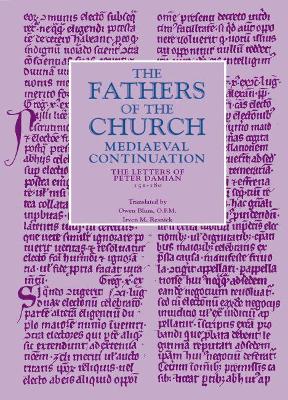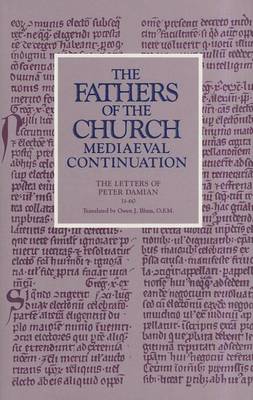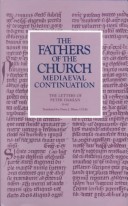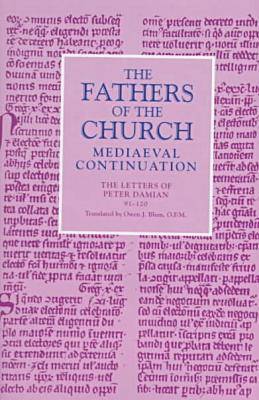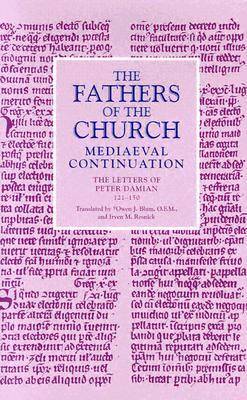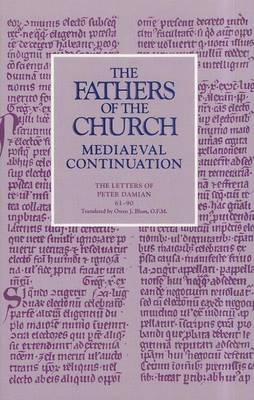Fathers of the Church: Mediaeval Continuation S.
6 total works
v. 7
This volume concludes the series of Peter Damian's Letters in English translation. Among Letters 151-180 readers will find some of Damian's most passionate exhortations on behalf of eremitic ideals. These include Letter 152, in which Damian defends as consistent with the spirit and the letter of Benedict's Rule his practice of receiving into the eremitic life monks who had abandoned their cenobitic communities. In Letter 153 Damian encourages monks at Pomposa to pass beyond the minimum standards established in the Rule of St. Benedict for the higher and more demanding eremitic vocation. In Letter 165, addressed to a hermit, Albizo, and a monk, Peter, Damian reveals as well the importance of monastic life to the world: because the integrity of the monastic profession has weakened, the world has fallen even deeper into an abyss of sin and corruption and is rushing headlong to destruction. Let monks and hermits take refuge within the walls of the monastery, he urges, while outside the advent of Antichrist seems imminent. Only from within their walls can they project proper examples of piety and sanctity that may transform the world as a whole.
Damian was equally concerned to address the moral condition of the larger Church. Letter 162 represents the last of Damian's four tracts condemning clerical marriage (Nicolaitism). Damian's condemnation of Nicolaitism also informed his rejection of Cadalus, the antipope Honorius II (see Letters 154 and 156), who was said to support clerical marriage, and therefore cast him into the center of a storm of ecclesiastical (and imperial) politics from which Damian never completely extricated himself.
Damian was equally concerned to address the moral condition of the larger Church. Letter 162 represents the last of Damian's four tracts condemning clerical marriage (Nicolaitism). Damian's condemnation of Nicolaitism also informed his rejection of Cadalus, the antipope Honorius II (see Letters 154 and 156), who was said to support clerical marriage, and therefore cast him into the center of a storm of ecclesiastical (and imperial) politics from which Damian never completely extricated himself.
v. 2
This second volume of the Mediaeval Continuation contains Letters 31-60 of Peter Damian, the 11th-century monk and man of letters. While his epistolary style is varied - exhortatory, occasional, pastoral, reforming - his message is singular and simple in urging strict adherence to the canons of the Church. In Letter 31, also known as the "Book of Gomorrah", Damian deplores the degradation of the priesthood through the vice of sodomy and appeals to Pope Leo IX to educate and purge the clergy. In Letter 40, called the "Liber gratissimus" he opposes the reordination of those ordained by simonists. Among the more personal letters are 55 and 57. In the former Damian writes of a long, debilitating illness, so serious that funeral preparations had been made, and of his immediate recovery when his brethren gave food to 100 poor people. In the latter, he writes again of his ill health and begs to be relieved of the administration of the diocese of Gubbio and permitted to return to Fonte Avellana and his "beloved solitude". Letter 58, addressed to Henry the archbishop of Ravenna in 1058, is the best example in the collection of Damian's political and ecclesiastical influence.
In it he gives his opinion of Benedict X and Nicholas II, the two candidates for the Apostolic See. He makes no effort to conceal his strong opinions but rather requests that this letter be made public so that all may learn what he thinks about the subject. This is perhaps, after all, what he would have hoped for the entire collection.
In it he gives his opinion of Benedict X and Nicholas II, the two candidates for the Apostolic See. He makes no effort to conceal his strong opinions but rather requests that this letter be made public so that all may learn what he thinks about the subject. This is perhaps, after all, what he would have hoped for the entire collection.
v. 1
v. 5
This fifth volume of the Mediaeval Continuation is the fourth of the letters of Peter Damian, an 11th-century monk and man of letters. Written during the years 1062-1066, these letters deal with a wide variety of subjects. Some letters are of historical interest, others approach the size and scope of philosophical or theological treatises. Damian's correspondents range from simple hermits in his community to abbots, bishops, cardinals and even to Pope Alexander II. Among these letters are to be found one addressed to the patriarch of Constantinople, two to Damian's sisters, one to the Empress Agnes, and even a few to such distant personages as the young King Henry IV and the Archbishop Anno of Cologne. Like its companions, this volume uses Damian's thought to understand an important period in the history of church and state. Clearly, the most significant letter in this collection is Letter 119, written in 1063 to Abbot Desiderius of Monte Cassino and his monks, on the omnipotence of God. Damian's treatise on "Divine Omnipotence" demonstrates his control of both theological and philosophical methodology.
His opponents are contemporary rhetoricians whose denial of God's total potency in dealing with his creatures' contingencies in time past, present and future opens them to the charge of heresy.
His opponents are contemporary rhetoricians whose denial of God's total potency in dealing with his creatures' contingencies in time past, present and future opens them to the charge of heresy.
v. 6
This volume, the fifth in the series of volumes containing the 180 letters written by the 11th-century monk Peter Damian, contains careful and annotated translations of Damian's Letters 121-150. Written during the years 1062-66, the letters deal with a wide variety of subjects and provide a contemporary account of many of the controversies of the gripping period in the history of church and state. Included here are several letters addressed to kinsmen. Letter 123 is Damian's rather lengthy exhortation to his nephew Damianus encouraging him to seek a pure and virtuous monastic life. Letter 132, written to his nephew Marinus, contains a comprehensive discussion on the virtues proper to the monastic life. And Letter 126 to Alberic of Monte Cassino, presents a good example of Damian's principles of biblical exegesis.
v. 3
Peter Damian (1007-1072), an 11th-century monk and man of letters, left a large and significant body of correspondence. This third volume of "The Letters of Peter Damian" is an annotated translation of Letters 61-90. These letters reveal the author's concern with the contemporary need for reforms, centering on clerical, especially episcopal, celibacy and on the "heresy" of simony which involved the purchase of ecclesiastical offices. Because Damian's Latin was a living language that surpasses the ability of classical Latin lexicography to cope with it, all disciplines that make use of medieval thought will welcome this English translation. Owen J. Blum's notes to each letter indicate the vocabulary problems he encountered and how they were resolved. This third volume, like its companions, uses Damian's thought to understand an important and gripping period in the history of church and state.
